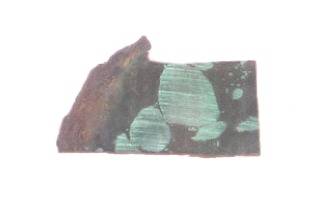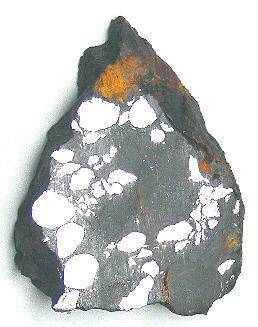CBa, bencubbinite

Found 1926, recognized 1940
35° 30′ N., 98° 42′ W. A mass of 2 kg was plowed up in Custer County, Oklahoma and later recognized as a meteoriteWork in progress. A solid natural object reaching a planet’s surface from interplanetary space. Solid portion of a meteoroid that survives its fall to Earth, or some other body. Meteorites are classified as stony meteorites, iron meteorites, and stony-iron meteorites. These groups are further divided according to their mineralogy and Click on Term to Read More. Weatherford is a primitive, polymict, chondritic brecciaWork in Progress ... A rock that is a mechanical mixture of different minerals and/or rock fragments (clasts). A breccia may also be distinguished by the origin of its clasts: (monomict breccia: monogenetic or monolithologic, and polymict breccia: polygenetic or polylithologic). The proportions of these fragments within the unbrecciated material Click on Term to Read More containing cm-sized clasts of a metalElement that readily forms cations and has metallic bonds; sometimes said to be similar to a cation in a cloud of electrons. The metals are one of the three groups of elements as distinguished by their ionization and bonding properties, along with the metalloids and nonmetals. A diagonal line drawn Click on Term to Read More host (~60 vol%) and a maficOne of the two broad categories of silicate minerals, the other being felsic, based on its magnesium (Mg) and/or iron (Fe) content. Mafic indicates silicate minerals that are predominantly comprised of Mg and/or Fe.The term is derived from those major constituents: Magnesium + Ferrum (Latin for iron) + ic (having Click on Term to Read More silicateThe most abundant group of minerals in Earth's crust, the structure of silicates are dominated by the silica tetrahedron, SiO44-, with metal ions occurring between tetrahedra). The mesodesmic bonds of the silicon tetrahedron allow extensive polymerization and silicates are classified according to the amount of linking that occurs between the host (~40 vol%), along with ordinary chondriteWork in Progress Ordinary chondrites (OCs) are the largest meteorite clan, comprising approximately 87% of the global collection and 78% of all falls (Meteoritical Society database 2018)1. Meteorites & the Early Solar System: page 581 section 6.1 OC of type 5 or 6 with an apparent shock stage of S1, Click on Term to Read More, R-chondrite, carbonaceous, and other xenolithic clasts.
One ordinary
chondriteChondrites are the most common meteorites accounting for ~84% of falls. Chondrites are comprised mostly of Fe- and Mg-bearing silicate minerals (found in both chondrules and fine grained matrix), reduced Fe/Ni metal (found in various states like large blebs, small grains and/or even chondrule rims), and various refractory inclusions (such Click on Term to Read More xenolithFragment of a rock or meteorite that formed apart from the host material. Click on Term to Read More classified petrologically as >3.5 is composed of 85%
chondrulesRoughly spherical aggregate of coarse crystals formed from the rapid cooling and solidification of a melt at ~1400 ° C. Large numbers of chondrules are found in all chondrites except for the CI group of carbonaceous chondrites. Chondrules are typically 0.5-2 mm in diameter and are usually composed of olivine Click on Term to Read More of a size closest to that of H
chondritesChondrites are the most common meteorites accounting for ~84% of falls. Chondrites are comprised mostly of Fe- and Mg-bearing silicate minerals (found in both chondrules and fine grained matrix), reduced Fe/Ni metal (found in various states like large blebs, small grains and/or even chondrule rims), and various refractory inclusions (such Click on Term to Read More, as well as an FeNi and FeS content very similar to that of H chondrites. However, the O-isotopic composition is unlike that of any other ordinary chondrite group or a chondritic
clastA mineral or rock fragment embedded in another rock. Click on Term to Read More that was found in CB
a Bencubbin. The unique type 3 carbonaceous xenoliths have been characterized as dehydrated CM-like chondritic material. Very small olivine-rich clasts resembling Rumuruti-like material have also been found. These xenoliths are highly equilibrated to type 6 and devoid of chondrules.
While
refractory inclusionsInclusions found predominantly in carbonaceous chondrites and are rich in refractory elements particularly calcium, aluminum and titanium that in various combinations form minerals such as spinel, melilite, perovskite and hibonite. There are two types of refractory inclusion: • Ca Al-rich inclusions (CAIs) • Amoeboid olivine aggregates (AOAs) Refractory inclusions were Click on Term to Read More have only been found in the HaH 237, QUE 94411, and Gujba bencubbinites, and the transitional member Isheyevo, cm-size
chondruleRoughly spherical aggregate of coarse crystals formed from the rapid cooling and solidification of a melt at ~1400 ° C. Large numbers of chondrules are found in all chondrites except for the CI group of carbonaceous chondrites. Chondrules are typically 0.5-2 mm in diameter and are usually composed of olivine Click on Term to Read More fragments of barred
olivineGroup of silicate minerals, (Mg,Fe)2SiO4, with the compositional endpoints of forsterite (Mg2SiO4) and fayalite (Fe2SiO4). Olivine is commonly found in all chondrites within both the matrix and chondrules, achondrites including most primitive achondrites and some evolved achondrites, in pallasites as large yellow-green crystals (brown when terrestrialized), in the silicate portion Click on Term to Read More composition occur in all group members. The metal in Weatherford records the effects of a late shock event ~0.5 b.y. after
accretionAccumulation of smaller objects into progressively larger bodies in the solar nebula leading to the eventual formation of asteroids, planetesimals and planets. The earliest accretion of the smallest particles was due to Van der Waals and electromagnetic forces. Further accretion continued by relatively low-velocity collisions of smaller bodies in the Click on Term to Read More (~4.2 b.y. ago) in which recrystallization and minor impact-melting occurred. It is proposed that this silicate melt phase, which itself contains tiny
immiscibleThe property of liquids that are mutually insoluble (won't mix together) such as oil and water or metallic and silicate melts. Click on Term to Read More blebs of FeNi-metal, thereafter infiltrated the space between the metal and silicate fragments leading to reheating of the metal particles to temperatures of ~400°C (Chappell
et al., 2011; Srinivasan
et al., 2013). A significant component of these
kamaciteMore common than taenite, both taenite and kamacite are Ni-Fe alloys found in iron meteorites. Kamacite, α-(Fe,Ni), contains 4-7.5 wt% Ni, and forms large body-centered cubic crystals that appear like broad bands or beam-like structures on the etched surface of a meteorite; its name is derived from the Greek word Click on Term to Read More grains (~40%) have both homogenous and exsolved (the latter from late-stage impact reheating to <600°C) Cr-rich sulfide inclusions occurring in arcuate textures along metal grain boundaries, rarely containing metal blebs (Srinivasan
et al., 2014). Host metal elemental abundance ratios are correlated with those of the silicate host phase, providing evidence for a common nebular reservoir origin for the two host phases; the FeNi-metal blebs likely formed through nebular condensation or silicate
reductionOxidation and reduction together are called redox (reduction and oxidation) and generally characterized by the transfer of electrons between chemical species, like molecules, atoms or ions, where one species undergoes oxidation, a loss of electrons, while another species undergoes reduction, a gain of electrons. This transfer of electrons between reactants Click on Term to Read More processes (possibly initiated through impact shock heating).
All of the bencubbinites are characterized by a significant enrichment in planetary-type rare gases and isotopically heavy
nitrogenPrincipal constituent of the Earth’s atmosphere (78.08 vol. % at ground level). Nitrogen is the fifth most abundant element in the universe by atom abundance. Nitrogen comprises only 3.5 vol. % of the atmosphere of Venus and 2.7 vol. % of Mars’s atmosphere. Nitrogen has two isotopes: 14N (99.632 %) and 15N Click on Term to Read More (
15N). Contrary to other bencubbinites, the main N-carrier phase in Weatherford is located in the shock-melted veinlets. A lesser source of heavy nitrogen, along with rare gases such as radiogenic
40Ar, has been found inside µm-sized vesicles within the silicate melt phase. The high oxide content within this vesicle-containing melt phase is consistent with
fractionationConcentration or separation of one mineral, element, or isotope from an initially homogeneous system. Fractionation can occur as a mass-dependent or mass-independent process. Click on Term to Read More processes resulting from a high-temperature shock event. This chemically reactive environment could lead to the release of N, creating the N- and Ar-rich vesicles.
Bencubbinites have been divided into two petrologic subgroups, CB
a and CB
b, representing those with cm-sized metal and silicate chondrules, and those with mm-sized chondrules. The CB, CH, and CR chondrites constitute the CR clan, comprising groups which likely formed in the same isotopic reservoir under similar conditions in the
solar nebulaThe primitive gas and dust cloud around the Sun from which planetary materials formed.. The best current evidence supports an origin for these late-formed metal-rich carbonaceous chondrites in an impact plume generated by a hypervelocity collision between planetary embryos (Krot
et al., 2009). The ‘Grand Tack’ model of Walsh
et al. (2011) could have generated such high velocities; further details about the ‘Grand Tack’ scenario can be found in the
Appendix Part III. Planetary modeling employed by Johnson
et al. (2016) demonstrates that only during a relatively short timeframe within this migration period will impact velocities reach levels high enough (>18 [±5] km/s) to vaporize Fe in a planetesimal
coreIn the context of planetary formation, the core is the central region of a large differentiated asteroid, planet or moon and made up of denser materials than the surrounding mantle and crust. For example, the cores of the Earth, the terrestrial planets and differentiated asteroids are rich in metallic iron-nickel. Click on Term to Read More. It is notable that the timing of the inward migration of Jupiter and Saturn is consistent with the timing of the accretion of CB chondrites from an impact-generated vapor plume, occurring ~4.8. m.y. after
CAIsSub-millimeter to centimeter-sized amorphous objects found typically in carbonaceous chondrites and ranging in color from white to greyish white and even light pink. CAIs have occasionally been found in ordinary chondrites, such as the L3.00 chondrite, NWA 8276 (Sara Russell, 2016). CAIs are also known as refractory inclusions since they Click on Term to Read More (Scott
et al., 2018).
Following condensation of the various components, they were aerodynamically sorted according to their velocity, size, and
densityMass of an object divided by its volume. Density is a characteristic property of a substance (rock vs. ice, e.g.). Some substances (like gases) are easily compressible and have different densities depending on how much pressure is exerted upon them. The Sun is composed of compressible gases and is much Click on Term to Read More as they spread out into the local nebular gas in a typical fan-shaped pattern. It was calculated by Morris
et al. (2012) that in ~1% of the impacts the host planetesimal would be propelled in the direction of the impact plume, sweeping up some of the aerodynamically sorted
ejectaFractured and/or molten rocky debris thrown out of a crater during a meteorite impact event, or, alternatively, material, including ash, lapilli, and bombs, erupted from a volcano. Click on Term to Read More within a short time period measured in weeks. They reason that this re-accreted material would have been mixed with existing crustal components to form a layer many meters thick. See the
HaH 237 page for a more detailed scenario of the CB group formation process ascertained by Fedkin
et al. (2015) through kinetic condensation modeling.
The specimen shown above is a 2.54 g polished partial slice of Weatherford. This specimen was acquired from Steve Arnold (International Meteorite Brokerage) in 2000, who had obtained it through a trade with the Smithsonian Institution, and was subsequently traded to another collector in 2018. The photo below shows a larger 22 g slice of this rare bencubbinite in the J. Piatek Collection, acquired from the National Museum of Natural History, Smithsonian Institution.

Photo courtesy of the J. Piatek Collection








